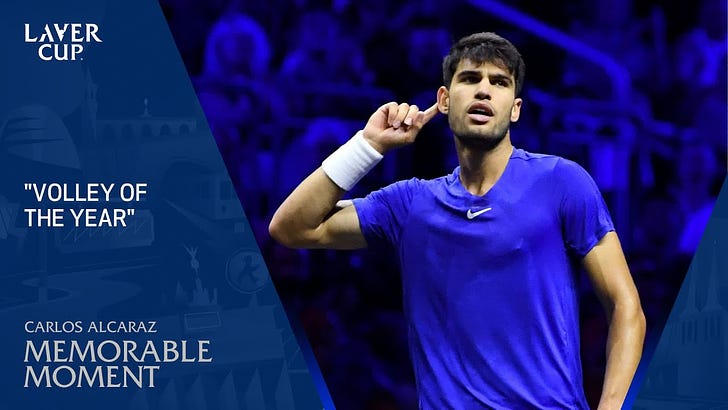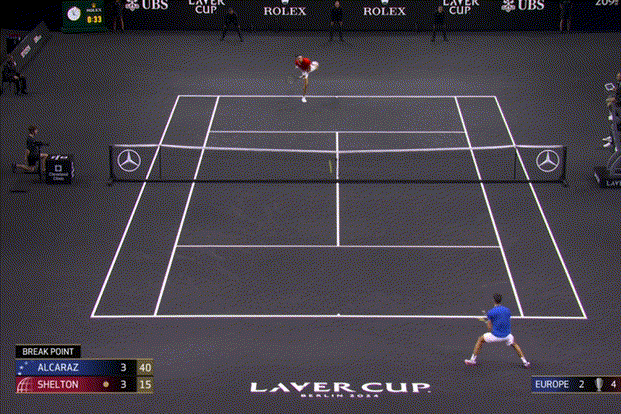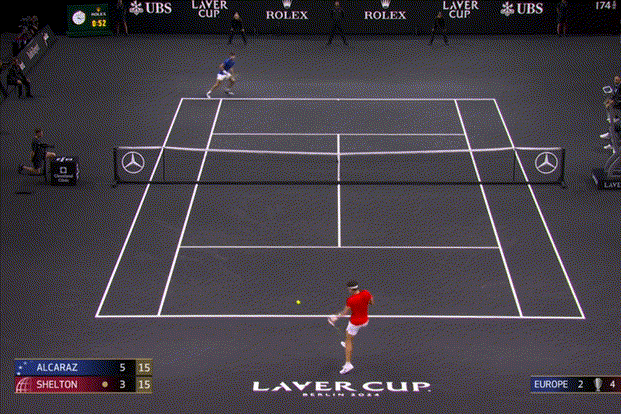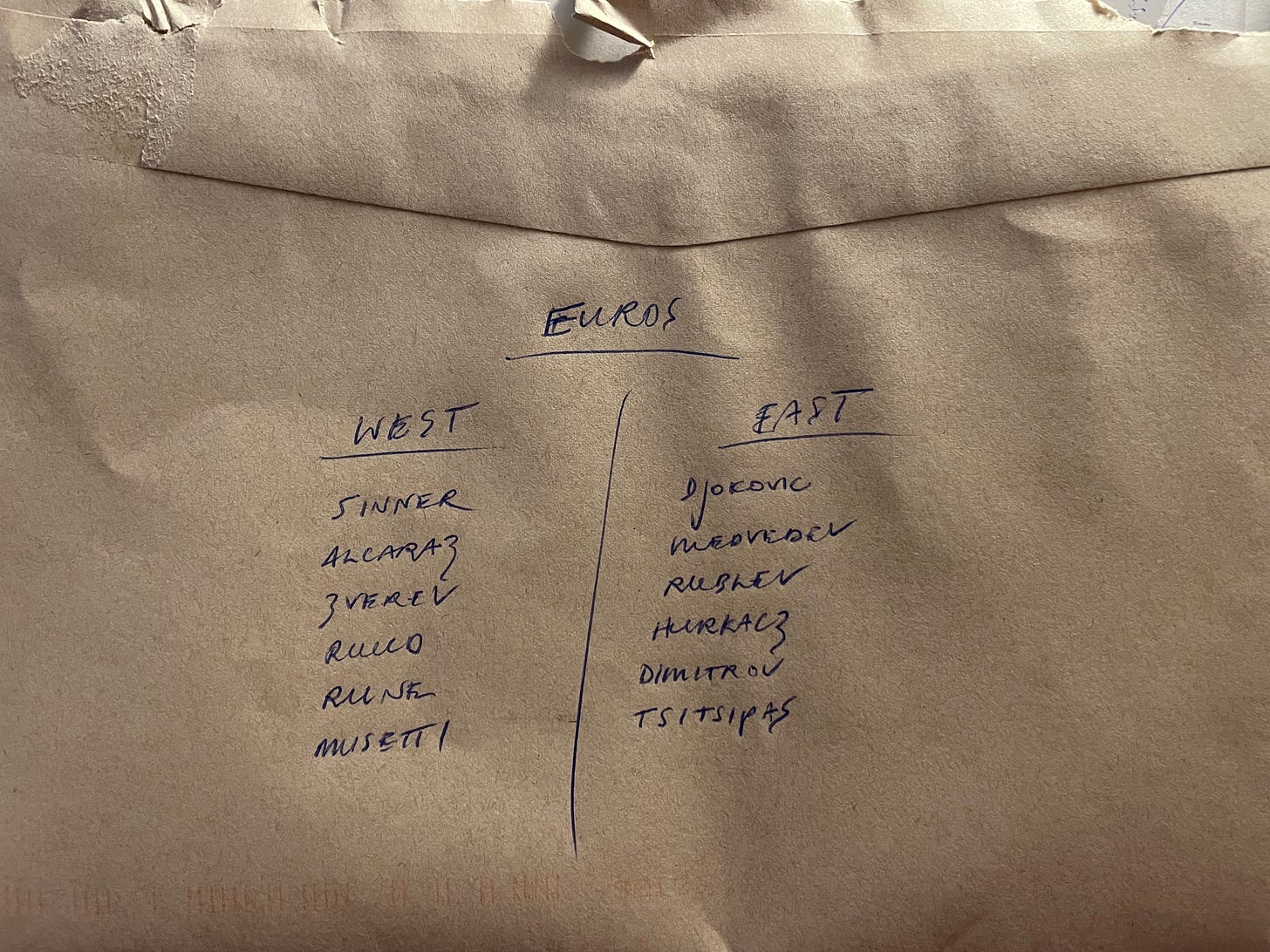Laver Cup; Davis Cup; Euro Dominance
Alcaraz — aesthetics — defensive backhand slices — European dominance
Carlos Alcaraz shouldered Team Europe with two stunning performances on the final day of play to defeat Team World 13-11 at the 2024 Laver Cup in Berlin on Sunday.

I don’t know why I bothered with the scoresheet and shoddy display of Excelmanship; the Laver Cup is essentially an exhibition event masquerading as a competitive Ryder-Cup-styled Europe versus the United States World.1
That doesn’t mean it was any less entertaining. The Laver Cup knows what it is and leans into it from every angle. A cursory view of the Laver Cup YouTube account has all sorts of short clips that are derivative of the matches themselves, such as player reactions from the bench and locker room, team walkouts, and court-side coaching from fellow players. The whole format is geared toward aesthetics and star power, with the competitive stakes sprinkled on top by the natural drive of the athletes.
And if the numbers are anything to go by, the Laver Cup weekend was a success in terms of viewership.
However, assembling all that star-power in a rotating cast of cities does make it expensive, as Christopher Clarey pointed out in his piece:
“But though the Laver Cup does not have ranking points or tradition, it does have more potential to create widespread interest than most of the tournaments on the circuit. That seems a sufficient raison d’être, although no guarantee of its long-term viability. It has a high overhead with its large player budget, premium presentation and current approach of changing cities for each edition. It has not made a profit every year despite ticket prices that many fans deem exorbitant, but it is no doubt a significant cut above much of the competition.”
Given its proximity to the recent Davis Cup final group stage matches (yeah, I barely noticed too), it served as a reminder for why Davis Cup is lacking as a product. Once the pinnacle of team tennis, some Davis Cup group stage matches slip by largely unnoticed — and unattended — as a post-US Open event spread out across four venues. It therefore results in matches between countries played on neutral territory. No points for guessing how many people showed up in Manchester, England, for the Finland versus Canada match.

Unlike Laver Cup, the Davis Cup is not founded on aesthetics, but on victory. Such a format requires invested partisans, as I wrote for a piece on Padel and Pickleball (emphasis added):
Partisans watch sports (and usually that of a team) to see a victory; it doesn't matter how. They want the win and contend that sport is about victory.
“Beauty may be a by-product of victory, and of playing for victory, but it never should be the primary aim” (p. 4).
From this perspective, if an athlete starts trying to entertain, rather than simply win in the most effective manner (I’m looking at Kyrgios, Monfils, perhaps even Alcaraz), and the spectator enjoys that, then Mumford suggests “they [ the spectator] may have ceased being a sports fan and instead they have become an art-appreciator, perhaps” (p. 7). Certain conditions can sway how one perceives a sporting contest, and thus, how partisan they are. If one has ever bet on the outcome of an event, for example, they probably didn’t care as much for the spectacle as they did for the victory. But a purist watches sports for entirely different reasons. They don't care who wins as long as the spectacle is great and the game is played well.
In this sense, Laver Cup is for purists and Davis Cup is for partisans. As a result, it’s imperative that Davis Cup bring back home-and-away ties that stoke national spirits if they are to avoid their current slide into irrelevancy.
Sidenote: the world record attendance for a competitive tennis match was the 2014 Davis Cup final between Switzerland and France, where Federer and Wawrinka helped Switzerland to its first title (highlights).
With that said, I did catch some highlights of Laver Cup matches.
(sidenote two: tennis is so hard to follow even for diehard fans — who is streaming? Do I need a VPN? How much? What time? This sport burns a hole through your wallet and circadian rhythm in equal measure).
Based on my limited viewing the tennis was electric. Or perhaps, more accurately, Carlos Alcaraz was electric. His singles matches against Ben Shelton and Taylor Fritz were typical of his “explosively finessed” synthetic brand, and he hit the shot of the tournament in a similar manner during a doubles match, feathering the outer meridians of the ball to arc a backhand volley on an unchartered path that spun closely by the Mercedes-Benz net logo.
There was also this interesting SkyCam-quarterback-inspired replay angle that caught my attention:
Other notes from the Alcaraz/Shelton match
Alcaraz’s defensive slice adjustments against the lefty. Part I.

Part II: has there ever been a two-hander with such feel and control on their slice? One of those little details of his game that only get aired three or four times a match, but that are so crucial to making him a prolific defender.
Part III: This one was sick. It’s Nadal end-range physicality blended with Federer finesse and feel. Again note the chip over the Shelton backhand.
Part IV:

Also: just straight outta 1999.
Anyway, can the Laver Cup become more than this? As in, can it move beyond its entertainment roots and develop into a fierce rivalry? I’m not sure it can or that it needs to or wants to, but if it did, the main issue is highlighted nicely in this rather long table from the No Challenges Remaining twitter account:

Europe and a dash of South America have won all the men’s slams for the last 20 years. A cursory look at the current rankings show nine of the top 10 men and 14 of the top 20 (shoutout to the US with five men in the top 20) hailing from Europe. While the ratios even out slightly for the top 100 (37 from the world), that’s somewhat irrelevant as the Laver Cup’s mechanism is about assembling star power and making them face off. The only memorable match from Laver Cup history that comes to mind for me was Federer vs Kyrgios from the inaugural 2017 edition.
Yeah, it was pretty cool to see the Big-4 on the same team back-slapping and giving each other coaching advice. But finding a way to reliably make them play against each other in a teams format each year?
For a more evenly matched affair, a quick back of the envelope East vs. West Euros tournament would look something like this currently:
Of course, who is to say that the next crop of stars aren’t from the world? I think it’s an uphill battle given the 20-odd year of evidence that learning the game on clay does wonders to developing you for the modern game. Gill Gross and Alex Gruskin recently did a mock draft of players under 24 (excluding Sinner and Alcaraz), and perusing their lists, the top picks were also mainly from Europe, with the exceptions including Ben Shelton and Brazil’s Joao Fonseca (who I am really big on, and who — unsurprisingly — grew up on clay). The fact that South America — a relatively poorer continent in terms of money and professional tennis offerings — have produced players like del Potro, Gaudio, Coria, Nalbandian, Gonzalez, and now Fonseca (again I must emphasise that I think this kid is slam-winning material) is all the more convincing.
Despite all the money the USTA and Tennis Australia have at their disposal, they haven’t invested in the one ingredient that seems to matter: a boatload of lower-level professional events on clay courts in their own backyards. Way back when I started this newsletter I wrote a piece titled Modern Champions are Made From Clay. An excerpt with some graphs:
While training on clay is helpful, playing on clay is better. Matches are the ultimate practice; nothing else comes close. If we take a look at the lower level Challenger and Futures tournaments (the breeding ground of the next and upcoming players) we see that Europe’s clay and hard court offering is far more balanced, and skewed in favour of clay, on top of simply having more events.
Futures events aren’t much different:
Another excerpt to finish:
This is not exactly a revolutionary secret; the US and Australian tennis bodies have acknowledged that clay court tennis helps a player develop for the modern day game, and some clay courts have been installed at national training facilities in both countries. Yet, no champion has emerged. Maybe it will take more time, but plenty of young talent in the last ten years has still mainly come from Europe: Zverev, Tsitsipas, Berrettini, Ruud, Rublev, Alcaraz, and Sinner to name a few. Two young Canadians in Felix Auger Aliassime and Denis Shapovalov seem to show promise, but there credentials so far are heavily skewed to fast hard courts and grass, and in my opinion, their games are lacking in the areas clay would have developed: return of serve, angles, defence, drop shots—the kind of tennis IQ everyone has been drooling about from 18-year-old Spaniard, Carlos Alcaraz, in recent weeks.
For what it’s worth, the Davis Cup finals — to be hosted in Malaga in November — currently have Italy and Spain as the top seeds. It’s possible we get Alcaraz and Sinner duking it out in the final in what would certainly be aesthetics and victory maximised.
That’s all for now. I’ll see you in the comments, and hopefully be back with some recaps from the Asian swing. HC
The winners receive $250,000 each, and the losing team receives nothing, so there is that. But let’s not pretend that some players aren’t picked to satisfy the theatrical elements at the expense of winning matches.













I think Shelton is the american that would have most benefitted from more time on the dirt growing up, to me rally tolerance and concentration feel like his biggest weaknesses.
The Ruud / Tsitsipas vs Tabilo / Shelton was really a returning disaster class, but always nice to see that those left sliders trouble some pro's just as much as us park hackers.
Can you elaborate on the point "keeps his left arm low and close to the torso on the forehand chip return to keep his upper body side on and still"? Does this setup apply to doing FH drop shots where torso rotation is not necessary?